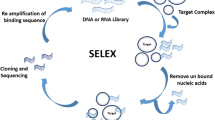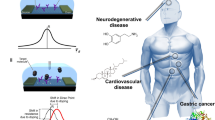Abstract
Carbon-based mesoporous foam nanostructures have gained significant attention because of features like high specific surface area, stability, abundant porosity, good conductivity, and excellent biocompatibility. Highly mesoporous carbon foam (MCF) was properly synthesized via the low-cost, template-free, simplistic Pechini method. Functional nanomaterials can be incorporated into the surface of MCFs to design functionalized MCFs for a broader range of applications. This opens up new horizons for designing MCFs that can be used in various fields. This study aims to introduce a new type of MCF decorated with carboxylated single-wall carbon nanotubes (CSWCNTs) and silver nanoparticles (AgNPs). An amine-functionalized aptamer was immobilized on the modified glassy carbon electrode (GCE) by covalent bonds and electrostatic interactions to determine carcinoembryonic antigen (CEA) in serum samples. The designed aptasensor best operated at 0.05 V (vs. Ag/AgCl) and showed a wide linear range from 1 × 10−6 to 20 ng mL−1, high sensitivity (27.96 μA mL ng−1 cm−2), low limit of detection (0.30 fg mL−1), high bioaffinity, superior selectivity, and good reproducibility. As the results indicated, the AgNPs/CSWCNT/MCF nanocomposite–based homogenous aptasensor platform has great potential for the low-cost clinical detection of other tumor markers in complex biological environments.







Similar content being viewed by others
References
Sung H, Ferlay J, Siegel RL, Laversanne M, Soerjomataram I, Jemal A, Bray F (2021) Global cancer statistics 2020: GLOBOCAN estimates of incidence and mortality worldwide for 36 cancers in 185 countries. CA Cancer J Clin 71:209–249
Song Q, Merajver SD, Li JZ (2015) Cancer classification in the genomic era: five contemporary problems. Hum Genomics 9:1–8
Gold P, Freedman SO (1965) Demonstration of tumor-specific antigens in human colonic carcinomata by immunological tolerance and absorption techniques. J Exp Med 121:439–462
Vogel I, Francksen H, Soeth E, Henne-Bruns D (2001) The carcinoembryonic antigen and its prognostic impact on immunocytologically detected intraperitoneal colorectal cancer cells. Am J Surg 181:188–193
Naghibalhossaini F, Ebadi P (2006) Evidence for CEA release from human colon cancer cells by an endogenous GPI-PLD enzyme. Cancer Lett 234:158–167
Prete SP, Rossi L, Correale PP, Turriziani M, Baier S, Tamburrelli G, De VL, Bonmassar E, Aquino A (2005) Combined effects of protein kinase inhibitors and 5-fluorouracil on CEA expression in human colon cancer cells. Pharmacol Res 52:167–173
Tao Z, Du J, Cheng Y, Li Q (2018) Electrochemical immune analysis system for gastric cancer biomarker carcinoembryonic antigen (CEA) detection. Int J Electrochem Sci 13:1413–1422
Serdarevic N, Smajic J (2018) Comparison of chemiluminescent microparticle immunoassay (CMIA) with electrochemiluminescence immunoassay (ECLIA) for Carcinoembryonic antigen (CEA). J Heal Sci 8:94–100
Huang J-Y, Zhao L, Lei W, Wen W, Wang YJ (2018) A high-sensitivity electrochemical aptasensor of carcinoembryonic antigen based on graphene quantum dots-ionic liquid-nafion nanomatrix and DNAzyme-assisted signal amplification strategy. Biosens Bioelectron 99:28–33
Tian T, Liu H, Li L, Yu J, Ge S, Song X, Yan M (2017) Based biosensor for noninvasive detection of epidermal growth factor receptor mutations in non-small cell lung cancer patients. Sensors Actuators B Chem 251:440–445
Rashid JIA, Abdullah J, Yusof NA, Hajian R (2013) The development of silicon nanowire as sensing material and its applications. J Nanomater 2013:14
Mishra GK, Barfidokht A, Tehrani F, Mishra RK (2018) Food safety analysis using electrochemical biosensors. Foods 7:141
Alavi-Tabari SAR, Khalilzadeh MA, Karimi-Maleh H (2018) Simultaneous determination of doxorubicin and dasatinib as two breast anticancer drugs uses an amplified sensor with ionic liquid and ZnO nanoparticle. J Electroanal Chem 811:84–88
Hatamluyi B, Sadeghzadeh S, Rezayi M, Sany SBT (2023) Diazinon electrochemical biosensor mediated by aptamer and nanoscale porous carbon derived from ZIF-8. Sensors Actuators B Chem 381:133424
Baretta R, Raucci A, Cinti S, Frasconi M (2023) Porous hydrogel scaffolds integrating Prussian blue nanoparticles: A versatile strategy for electrochemical (bio) sensing. Sensors Actuators B Chem 376:132985
Yang J, Zou L (2014) Recycle of calcium waste into mesoporous carbons as sustainable electrode materials for capacitive deionization. Microporous Mesoporous Mater 183:91–98
Joshi A, Schuhmann W, Nagaiah TC (2016) Mesoporous nitrogen containing carbon materials for the simultaneous detection of ascorbic acid, dopamine and uric acid. Sensors Actuators B Chem 230:544–555
Cetinkaya A, Kaya S, Ozkan SA (2023) A collection of the best practice examples of electroanalytical applications in education: from polarography to sensors. J Solid State Electrochem 1–27
Mak CH, Liao C, Fu Y, Zhang M, Tang CY, Tsang YH, Chan HLW, Yan F (2015) Highly-sensitive epinephrine sensors based on organic electrochemical transistors with carbon nanomaterial modified gate electrodes. J Mater Chem C 3:6532–6538
Asadpour F, Mazloum-Ardakani M, Hoseynidokht F, Moshtaghioun SM (2021) In situ monitoring of gating approach on mesoporous silica nanoparticles thin-film generated by the EASA method for electrochemical detection of insulin. Biosens Bioelectron 180:113124
Szunerits S, Boukherroub R, Downard A, Zhu J (2017) Nanocarbon chemistry and interfaces. Wiley, Germany
Fiorito PA, Gonçales VR, Ponzio EA, de Torresi SIC (2005) Synthesis, characterization and immobilization of Prussian blue nanoparticles. A potential tool for biosensing devices. Chem Commun 366–368
Cao X, Wang N, Jia S, Guo L, Li K (2013) Bimetallic AuPt nanochains: synthesis and their application in electrochemical immunosensor for the detection of carcinoembryonic antigen. Biosens Bioelectron 39:226–230
Li H, Sun Z, Zhong W, Hao N, Xu D, Chen HY (2010) Ultrasensitive electrochemical detection for DNA arrays based on silver nanoparticle aggregates. Anal Chem 82:5477–5483
Ding X, Liu Y, Gao L, Guo L (2008) Synthesis and characterization of doped LaCrO3 perovskite prepared by EDTA–citrate complexing method. J Alloys Compd 458:346–350
Zhu X, Wu G, Lu N, Yuan X, Li B (2017) A miniaturized electrochemical toxicity biosensor based on graphene oxide quantum dots/carboxylated carbon nanotubes for assessment of priority pollutants. J Hazard Mater 324:272–280
Hakimian F, Ghourchian H (2020) Ultrasensitive electrochemical biosensor for detection of microRNA-155 as a breast cancer risk factor. Anal Chim Acta 1136:1–8
Kim K, Lee HB, Lee JW, Park HK, Shin KS (2008) Self-assembly of poly (ethylenimine)-capped Au nanoparticles at a toluene− water interface for efficient surface-enhanced Raman scattering. Langmuir 24:7178–7183
Sahraei N, Mazloum-Ardakani M, Khoshroo A, Hoseynidokht F, Mohiti J, Moradi A (2022) Electrochemical system designed on a paper platform as a label-free immunosensor for cancer derived exosomes based on a mesoporous carbon foam-ternary nanocomposite. J Electroanal Chem 920:116590
Wu Z, Sun L-P, Zhou Z (2018) Efficient nonenzymatic H2O2 biosensor based on ZIF-67 MOF derived Co nanoparticles embedded N-doped mesoporous carbon composites. Sensors Actuators B Chem 276:142–149
Rahsepar M, Foroughi F, Kim H (2019) A new enzyme-free biosensor based on nitrogen-doped graphene with high sensing performance for electrochemical detection of glucose at biological pH value. Sensors Actuators B Chem 282:322–330
Rouquerol J, Avnir D, Fairbridge CW, Everett DH, Haynes JM, Pernicone N, Ramsay JDF, Sing KSW, Unger KK (1994) Recommendations for the characterization of porous solids (Technical Report). Pure Appl Chem 66:1739–1758
Liu L, Zhao H, Shi L, Lan M, Zhang H, Yu C (2017) Enzyme-and metal-free electrochemical sensor for highly sensitive superoxide anion detection based on nitrogen doped hollow mesoporous carbon spheres. Electrochim Acta 227:69–76
Xia Y, Zhang W, Xiao Z, Huang H, Zeng H, Chen X, Chen F, Gan Y, Tao X (2012) Biotemplated fabrication of hierarchically porous NiO/C composite from lotus pollen grains for lithium-ion batteries. J Mater Chem 22:9209–9215
Jahanbakhshi M (2017) Mesoporous carbon foam, synthesized via modified Pechini method, in a new dispersant of Salep as a novel substrate for electroanalytical determination of epinephrine in the presence of uric acid. Mater Sci Eng C 70:544–551
Zhu J, Li H, Wang Y, Wang Y, Yan J (2021) Preparation of Ag NPs and its multifunctional finishing for cotton fabric. Polymers (Basel) 13:1338
Chew SY, Ng SH, Wang J, Novák P, Krumeich F, Chou SL, Chen J, Liu HK (2009) Flexible free-standing carbon nanotube films for model lithium-ion batteries. Carbon N Y 47:2976–2983
Habibi B, Jahanbakhshi M (2014) A novel nonenzymatic hydrogen peroxide sensor based on the synthesized mesoporous carbon and silver nanoparticles nanohybrid. Sensors Actuators B Chem 203:919–925
Liu Z, Xing Z, Zu Y, Tan S, Zhao L, Zhou Z, Sun T (2012) Synthesis and characterization of L-histidine capped silver nanoparticles. Mater Sci Eng C 32:811–816
Wang H, Sun J, Lu L, Yang X, Xia J, Zhang F, Wang Z (2020) Competitive electrochemical aptasensor based on a cDNA-ferrocene/MXene probe for detection of breast cancer marker Mucin1. Anal Chim Acta 1094:18–25
Zhang H, Wang Z, Zhang Q, Wang F, Liu Y (2019) Ti3C2 MXenes nanosheets catalyzed highly efficient electrogenerated chemiluminescence biosensor for the detection of exosomes. Biosens Bioelectron 124:184–190
Vajhadin F, Mazloum-Ardakani M, Shahidi M, Moshtaghioun SM, Haghiralsadat S, Ebadi A, Amini A (2022) MXene-based cytosensor for the detection of HER2-positive cancer cells using CoFe2O4@ Ag magnetic nanohybrids conjugated to the HB5 aptamer. Biosens Bioelectron 195:113626
He L, Li Z, Guo C, Hu B, Wang M, Zhang Z, Du M (2019) Bifunctional bioplatform based on NiCo Prussian blue analogue: label-free impedimetric aptasensor for the early detection of carcino-embryonic antigen and living cancer cells. Sensors Actuators B Chem 298:126852
Rahmati Z, Roushani M, Hosseini H (2021) Thionine functionalized hollow N-doped carbon nanoboxes: as a high-performance substrate for fabrication of label-free electrochemical aptasensor toward ultrasensitive detection of carcinoembryonic antigen. J Electroanal Chem 903:115858
Li J, Zhao L, Wang W, Liu Y, Yang H, Kong J, Si F (2021) Polymer-functionalized carbon nanotubes prepared via ring-opening polymerization for electrochemical detection of carcinoembryonic antigen. Sensors Actuators B Chem 328:129031
Wang D, Li Y, Lin Z, Qiu B, Guo L (2015) Surface-enhanced electrochemiluminescence of Ru@ SiO2 for ultrasensitive detection of carcinoembryonic antigen. Anal Chem 87:5966–5972
Huang X, Ni Z, Su H, Shang Y, Liu H, He Y, Meng H, Dong Y (2021) Cellulose nanocrystalline and sodium benzenesulfonate-doped polypyrrole nano-hydrogel/Au composites for ultrasensitive detection of carcinoembryonic antigen. New J Chem 45:5551–5560
Li H, Shi L, Sun D, Li P, Liu Z (2016) Fluorescence resonance energy transfer biosensor between upconverting nanoparticles and palladium nanoparticles for ultrasensitive CEA detection. Biosens Bioelectron 86:791–798
Mazloum-Ardakani M, Tavakolian-Ardakani Z, Sahraei N, Moshtaghioun SM (2019) Fabrication of an ultrasensitive and selective electrochemical aptasensor to detect carcinoembryonic antigen by using a new nanocomposite. Biosens Bioelectron 129:1–6
Funding
The authors wish to thank the Iran National Science Foundation (INSF) and Yazd University Research Council for the financial support of this research.
Author information
Authors and Affiliations
Corresponding author
Ethics declarations
Competing interests
The authors declare no competing interests.
Additional information
Publisher's Note
Springer Nature remains neutral with regard to jurisdictional claims in published maps and institutional affiliations.
Supplementary Information
Below is the link to the electronic supplementary material.
Rights and permissions
Springer Nature or its licensor (e.g. a society or other partner) holds exclusive rights to this article under a publishing agreement with the author(s) or other rightsholder(s); author self-archiving of the accepted manuscript version of this article is solely governed by the terms of such publishing agreement and applicable law.
About this article
Cite this article
Hoseynidokht, F., Mazloum-Ardakani, M., Sahraei, N. et al. Highly sensitive electrochemical detection of carcinoembryonic antigen by silver nanoparticles/carboxylated single-walled carbon nanotubes embedded in mesoporous carbon foam. J Solid State Electrochem 28, 377–387 (2024). https://doi.org/10.1007/s10008-023-05785-3
Received:
Revised:
Accepted:
Published:
Issue Date:
DOI: https://doi.org/10.1007/s10008-023-05785-3




